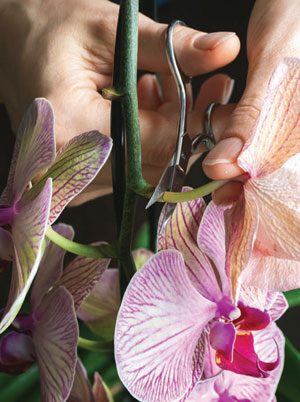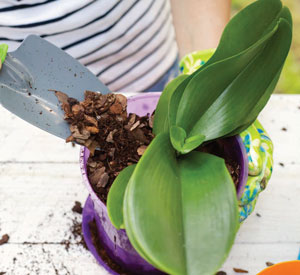Moth Orchids | The Perfect Cure for Winter

Orchids, once only available to the wealthy few who could afford greenhouses, have been democratized by the introduction of moth orchids that can be grown successfully in our homes. This graceful orchid, with its thick broad green leaves and arching flower sprays, is now widely available at a reasonable cost.
 Large flowers, ranging from pure white, pinks, purples, salmon and lemon yellow, bloom along the orchid’s stalk, opening one at a time. Your orchid will bloom for two to three months if properly cared for.
Large flowers, ranging from pure white, pinks, purples, salmon and lemon yellow, bloom along the orchid’s stalk, opening one at a time. Your orchid will bloom for two to three months if properly cared for.
Moth orchids bloom at approximately the same time each year, so it’s a good idea to purchase plants in the winter if you want winter blooms the following year. Look for an orchid with healthy green leaves; avoid yellow or shriveled leaves. For the longest flower show, pick an orchid with only one or two open blossoms.
 An east-facing window is an ideal location for orchids, or try a shaded southern or western window. Keep in mind that the orchid is a tropical plant that appreciates a moist environment. An easy way to increase humidity is to place pots on trays filled with gravel and water.
An east-facing window is an ideal location for orchids, or try a shaded southern or western window. Keep in mind that the orchid is a tropical plant that appreciates a moist environment. An easy way to increase humidity is to place pots on trays filled with gravel and water.
 Caring for your orchid
Caring for your orchid
Water only when the plant is nearly dry. The easiest way to judge when an orchid needs water is how it feels. A light pot means the plant needs water; if the pot feels heavy, wait a few days. Until you get used to judging your orchid by weight, reach in to feel the medium. Wait to water until it feels fairly dry.
When you water, simulate the tropics by saturating the bark, then draining away any excess water. If the pot is not too heavy and the outside temperature is reasonable, take the plant outside and pour lukewarm water (do not use salt-softened water) over the medium and let any excess water drain out. In the winter, you can water over the sink or a bucket. Always water in the morning so the foliage will dry before nightfall.
Misting is not a good idea as the moisture from misting is not the same as moisture circulating in the ambient air.
The fairly common practice of using ice cubes to water orchids, while easy, is not a good practice. Ice water, in general, is bad for plant roots and especially so for plants from the tropics. Another consideration is the fact that a couple of ice cubes will not saturate the growing medium.
Moth orchids appreciate being fertilized on a regular schedule. It’s best to use a balanced orchid fertilizer. Every three weeks run clear water through the bark to remove any excess fertilizer.
PRO TIP FROM MARGENE
I LIKE TO INTERSPERSE MOISTURE-LOVING FERNS WITH MY ORCHIDS. MOTH ORCHIDS ARE EPIPHYTES — PLANTS THAT GROW ON OTHER PLANTS (SUCH AS TREES) WITH THEIR ROOTS EXPOSED TO ATMOSPHERIC MOISTURE. THEY ARE GROWN IN A SOILLESS MEDIUM, USUALLY FIR BARK. IT IS NORMAL FOR ORCHIDS TO GROW ROOTS ABOVE THE SOIL. THESE GRAY AERIAL ROOTS SHOULD NOT BE TRIMMED. HOWEVER, DO CUT ANY ROOTS THAT ARE BROWN AS THAT INDICATES THEY ARE DEAD.
 New blooms
New blooms
When the last bloom has faded on your orchid plant, you can encourage more blooms by not removing the flower stem. Instead, cut the stem, leaving at least two nodes (the little brown lines on the stem below where the flowers were).
If the orchid is healthy, a second flower spike should grow from a node. You can also cut the spent stem entirely at the base where it comes out of the leaves. The plant should send out a new flower spike in two to three months.
 Time to repot
Time to repot
If your orchid starts to grow over the edge of the pot, it is time to either move the orchid to a larger pot or divide it. Even if your plant has not outgrown its container, keep an eye on the health of the planting medium. Once it has started to break down, it is essential to replace it to avoid root rot. The best time to repot is in the spring when root growth is active.
To repot, remove the old potting mix, trim any soft or rotted roots, and spread the remaining roots over new medium. Work the medium among the roots until the junction of the roots and stem is at the top of the medium. Do not trim the gray aerial roots. Resume regular watering, but do not fertilize until you see new growth.
Exotic beauty
Emerson wrote, “If eyes were made for seeing, then Beauty is its own excuse for being.” And the graceful moth orchid, indeed, can claim its reason for being, especially when snow covers the meadows and cold winds blow. ✦
East-facing Window, Epiphytes, Fir Bark, greenhouses, Moist Environment, Moth Orchids, Repot, Soilless Medium, Tropical Plant






